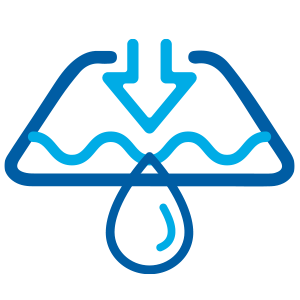
How to Manage Total Dissolved Solids in a Pool
Managing our pool's health and water chemistry balance can sometimes feel like a guessing game. Many common pool problems share similar symptoms, which makes it challenging to pinpoint exactly what the issue is. One pool dilemma often overlooked, or completely missed, is a high level of Total Dissolved Solids. In this post, we will discuss what Total Dissolved Solids are, how they affect your pool's health, and how to properly manage them.
What are Total Dissolved Solids?

There are many technical swimming pool terms and phrases that require a bit of deciphering to understand their meaning. Thankfully, the term Total Dissolved Solids is as straightforward as it gets! Also known as “TDS,” Total Dissolved Solids is the measurement of all dissolved solids and materials in your pool water. Most routine chemicals you add to your pool water, like chlorine and shock, contribute to the Total Dissolved Solids level. Other chemicals, minerals, salt, and microscopic contaminants also affect the sum of Total Dissolved Solids in your pool.
Evaporation is one of the main culprits for an increased Total Dissolved Solids count. As water evaporates from your pool, the solids in the water stay behind, resulting in a higher concentration. In addition, the level will increase marginally every time you add chemicals or other products to your water. Even your primary water source can have an impact on TDS levels, with some water sources having a naturally higher level of dissolved solids.
Total Dissolved Solids are generally not problematic, but that doesn't mean they should be ignored. Over time, you'll notice a gradual, continuous increase in the Total Dissolved Solids level, and this is normal. However, it's important to understand how Total Dissolved Solids impact your pool, and what you can do to help manage those levels.
PRO TIP: Struggling with cloudy pool water? Just because the water is cloudy doesn't always mean you're facing a problem with Total Dissolved Solids. There are many reasons you might be having trouble keeping your water clean and clear, including filtration and circulation issues. Check out our blog post for more troubleshooting tips: How to Quickly Clear Up Cloudy Pool Water. If you still suspect a problem with TDS, the best way to validate is to get your water tested.
How Total Dissolved Solids Affect Your Pool
Because the Total Dissolved Solids measurement accounts for all dissolved matter in your pool, the level is constantly rising. What does this mean for your pool?
Signs of a High Total Dissolved Solids Level
As your pool water continuously absorbs solids, good or bad, the potential for problems begins to rise. The ideal range of Total Dissolved Solids in freshwater pools is 0–2,500 ppm (parts per million), while saltwater pools support levels up to 5,000 ppm, or up to 1,500 ppm above the salt level reading.
One of the most common signs of an elevated Total Dissolved Solids level is difficulty maintaining water chemistry balance. As more solids dissolve in your pool, the water becomes saturated and can't properly absorb new chemicals. This process reduces the effectiveness of Free Available Chlorine in your pool, leading to unsanitized water. And as every pool owner knows, a pool with inadequate sanitization opens the door for all sorts of problems — including algae.
In addition to difficulty maintaining water chemistry, the following symptoms are indicative of a high TDS level:
- Faulty test readings for other aspects of water balance
- Difficulty maintaining correct water balance
- Salty-tasting water
- Scale buildup (if Calcium Hardness levels are also high)
- Skin and eye irritation
- Algae growth despite good sanitizer levels
- Cloudy or discolored water
- Metal corrosion (if the TDS level is above 5,000 ppm)
How to Test for Total Dissolved Solids
Standard test kits and strips, used for measuring other elements of water chemistry, do not test for Total Dissolved Solids in your pool water. Instead, you need a TDS meter to obtain an accurate reading of dissolved substances. TDS meters measure the electrical conductivity of your pool water, which indicates the volume of dissolved solids in your pool. While this test does not break down exactly which solids are in your pool, it does show if the level is higher than the acceptable amount.
PRO TIP: You don't always need a TDS meter to determine the amount of Total Dissolved Solids in your swimming pool. Leslie's includes a TDS reading with each of our free in-store AccuBlue® water tests. You'll be able to keep track of TDS trends each month in your pool so you can take a more active role in avoiding future water chemistry issues.
How to Reduce Total Dissolved Solids

Unfortunately, the only way to lower Total Dissolved Solids is by partially draining your pool and refilling it with fresh water. Much like Cynauric Acid and Calcium Hardness, there are no chemicals or products that will lower the concentration of dissolved substances in your pool.
If your pool has a high level of Total Dissolved Solids, it's time to drain your pool. However, we don't suggest draining all the water at once. We recommend draining and refilling one foot of water at a time until the TDS reading drops to a more appropriate level. Essentially, you're diluting with fresh water to bring the levels down. You can use a submersible pump to help drain the water. Alternatively, you can call or stop by your local Leslie's to ask about our pool draining services. For more tips and tricks, check out our blog post, Pool Draining 101, for the best tips on how to drain your pool. Remember to refer to your pool builder's or manufacturer's instructions for draining recommendations to avoid damaging your pool.
Managing the Total Dissolved Solids in your pool begins with understanding what they are, where they come from, and how they affect the water balance of your pool. Then, when necessary, you can maintain proper levels by introducing fresh water to bring the concentration down. If you have additional questions, stop by your local Leslie's to speak with one of our expert pool care professionals.